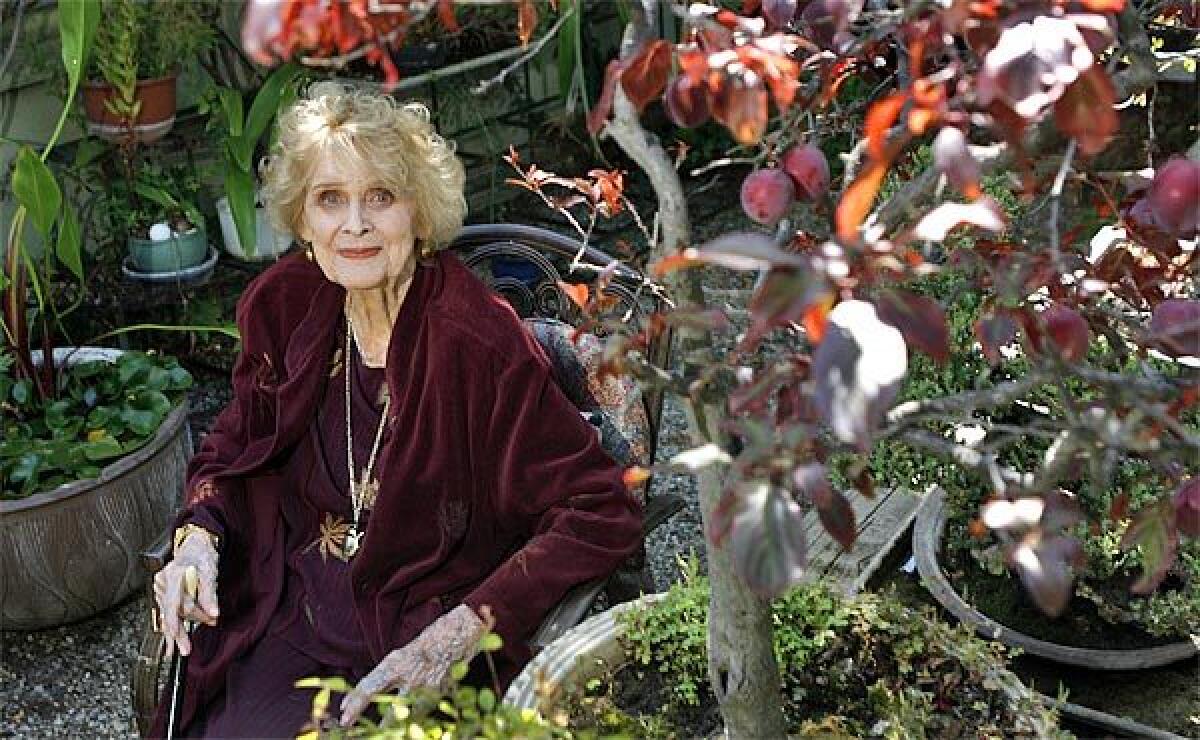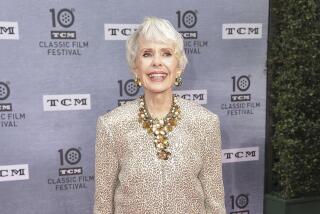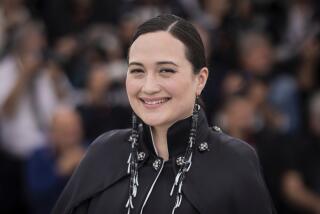Gloria Stuart dies at 100; ‘Titanic’ actress

Gloria Stuart, a 1930s Hollywood leading lady who earned an Academy Award nomination for her first significant role in nearly 60 years — as Old Rose, the centenarian survivor of the Titanic in James Cameron’s 1997 Oscar-winning film — has died. She was 100.
FOR THE RECORD:
Gloria Stuart: The obituary in the Sept. 28 LATExtra section of Gloria Stuart, the actress who became an artist and fine printer, said that her artwork is in the collection of the J. Paul Getty Museum in Los Angeles, among others. Her work is collected in the Getty Research Institute, not the museum. —
Stuart, a founding member of the Screen Actors Guild who later became an accomplished painter and fine printer, died Sunday night at her West Los Angeles home, said her daughter, writer Sylvia Thompson.
Stuart had been diagnosed with lung cancer five years ago.
“She also was a breast cancer survivor,” Thompson said, “but she just paid no attention to illness. She was a very strong woman and had other fish to fry.”
In July the actress was honored at an “Academy Centennial Celebration With Gloria Stuart” at the Samuel Goldwyn Theater in Beverly Hills.
“She was a charming and beautiful leading lady in the ‘30s, and I never understood why her career didn’t go further at that time,” film historian and critic Leonard Maltin, who interviewed Stuart on stage at the event, told The Times on Monday.
As for Stuart’s high-profile comeback in “Titanic”: “She was thrilled by the attention that that performance brought her and really wanted to win that Oscar. I thought she hit just the right notes in that performance. She was wry and engaging.”
As a glamorous blond actress under contract to Universal Studios and 20th Century Fox in the 1930s, Stuart appeared opposite Claude Rains in James Whale’s “The Invisible Man” and with Warner Baxter in John Ford’s “The Prisoner of Shark Island.”
She also appeared with Eddie Cantor in “Roman Scandals,” with Dick Powell in Busby Berkeley’s “Gold Diggers of 1935” and with James Cagney in “Here Comes the Navy.” And she played romantic leads in two Shirley Temple movies, “Poor Little Rich Girl” and “Rebecca of Sunnybrook Farm.”
But mostly she played what Stuart later dismissed as “stupid parts with nothing to do” — “girl reporter, girl detective, girl nurse” — and “it became increasingly evident to me I wasn’t going to get to be a big star like Katharine Hepburn and Loretta Young.”
After making 42 feature films between 1932 and 1939, Stuart’s latest studio contract, with 20th Century Fox, was not renewed. She appeared in only four films in the 1940s and retired from the screen in 1946.
By 1974, “the blond lovely of the talkies” had become an entry in one of Richard Lamparski’s “Whatever Happened to” books.
Writer-director Cameron’s $200-million “Titanic” changed that.
Stuart played Rose Calvert, the 100-year-old Titanic survivor who shows up after modern-day treasure hunters searching through the wreckage of the sunken ship find a charcoal drawing of her wearing a priceless blue diamond necklace.
Stuart’s performance as Old Rose frames the 1997 romantic- drama that starred Leonardo DiCaprio as lower-class artist Jack Dawson and Kate Winslet as the upper-class young Rose.
In “Gloria Stuart: I Just Kept Hoping,” her 1999 autobiography, Stuart said that after reading the script, “I knew the role I had wanted and waited for all these many years had arrived! I could taste the role of Old Rose!”
Cameron told The Times in a 1997 interview that he chose Stuart because he was “looking for a pro from the ‘30s or ‘40s, someone probably retired, maybe off the Hollywood radar for awhile.”
“I had to have someone who’d play the latter part of the life of someone we’d recognize, Kate Winslet, so it couldn’t be someone like Katharine Hepburn. We know so well what she looked like [when she was young],” Cameron said. “Gloria had just enough distance, and she gave this fantastic reading.”
At 87, Stuart became the oldest actress ever nominated for an Academy Award.
In addition to Oscar and Golden Globe nominations, she won a Screen Actors Guild award for outstanding performance by a female actor in a supporting role (tying with eventual Oscar-winner Kim Basinger for “L.A. Confidential”).
In the multiple-Oscar-winning blockbuster’s wake, Stuart found herself swamped with fan mail and interview requests. She also was faced with being recognized in the supermarket and finding her old films resurfacing on television. People magazine even named her one of the 50 most beautiful people in the world.
In 2000, several hundred fans gathered on Hollywood Boulevard next to the Egyptian Theater for the unveiling of Stuart’s star on the Hollywood Walk of Fame.
“I cannot begin to tell you how rewarding and nourishing and warming it is,” she said at the ceremony. “I wake up every day and say, ‘What a wonderful life. How lucky I am.’ ”
A third-generation Californian, she was born Gloria Stewart in Santa Monica on the Fourth of July, 1910. She later changed the spelling of her last name to Stuart, reasoning that the six letters would balance perfectly on a theater marquee with the six letters in “Gloria.”
In high school, she took classes in short-story and poetry-writing and worked for free as a “girl reporter” at the Santa Monica Outlook.
While attending UC Berkeley, where she acted in a campus theatrical group, Stuart met a handsome young sculptor, Gordon Newell. They were married in 1930 and moved to Carmel, where she worked on the local newspaper and appeared in little theater productions.
In 1932, after playing Masha in a little theater production of Chekhov’s “The Seagull” in Carmel, the visiting director asked her to play the role again in a small theater in the Los Angeles area.
Casting directors from both Paramount and Universal saw her performance and offered her screen tests. She wound up signing a seven-year contract with Universal: $125 a week to start, with singing and acting lessons included.
Stuart’s union activities began while making Whale’s 1932 horror comedy “The Old Dark House” with Boris Karloff and Melvyn Douglas.
“All of us were just exhausted by the long hours, and Melvyn Douglas leaned over to me in this theatrical way,” she recalled in a 1998 Los Angeles Times interview. “He whispered the word ‘union’ in my ear. And I thought, ‘Yes!’ ”
At the time, she wrote in her autobiography, “Actors worked unconscionable hours — especially females, because every morning our needs included a great deal of time in hairdressing and makeup. Meals were served at the convenience of the production staff. There was no allotment for travel time, no standard hours between work calls, no pay for overtime or double overtime — what we call golden time. And if an actor under contract refused a role the studio had chosen, he/she was suspended without pay — and the time was added on to the contract!”
Despite stiff studio resistance, the Screen Actors Guild was founded in 1933.
Discovering that she “took to politics like a duck to water,” Stuart helped form the Hollywood Anti-Nazi League in 1936, the same year she and writer Dorothy Parker helped organize the League to Support the Spanish War Orphans. She also became a member of the Hollywood Democratic Committee and was on the executive board of the California State Democratic Committee.
Stuart’s fledgling movie career took a toll on her marriage to Newell and they divorced. In 1934, she married screenwriter Arthur Sheekman, with whom she had her daughter Sylvia.
Stuart, whose career at Universal failed to take off, signed with 20th Century Fox in 1935.
After Fox declined to renew her contract in 1939, she acted in summer theater on the East Coast and made a failed attempt at Broadway before returning to Hollywood and turning her creative energies into the art of decoupage. She opened a shop on La Cienega Boulevard called Décor Ltd., which lasted more than four years.
In 1954, inspired by an exhibition of Impressionist paintings in Paris, she began painting. Her first one-woman show, at the Hammer Galleries in New York in 1961, was a critical hit. Art News called her “a deft primitive with a beguiling variety of subjects.” She went on to have exhibits in major galleries.
In 1975, four years after her husband was stricken with Alzheimer’s disease, Stuart decided to return to acting. From 1975 to 1988, she had about a dozen minor roles on TV and in movies, including dancing with Peter O’Toole in a nightclub scene in the 1982 film “My Favorite Year.”
As her husband became ill, Stuart began taking classes in bonsai. She became an honored member of local bonsai clubs, and her trees are in the bonsai collection at the Huntington Library, Art Collections and Botanical Gardens in San Marino.
Five years after Sheekman’s death in 1978, Stuart renewed a friendship with an old friend from her college years: Ward Ritchie, who had become a world-renowned master printer. The friendship quickly grew into an autumn romance. From Ritchie, Stuart developed an interest in fine letter-press printing and bought her own hand press.
She devoted much of her time to designing and printing artists’ books (handmade, letter-press printed books in limited editions, with her own artwork and writing). Her work is in the J. Paul Getty Museum in Los Angeles, the Metropolitan Museum of Art in New York City, the Victoria and Albert Museum in London and other museums.
About four months after Ritchie’s death in 1996 at 91, Stuart received a call from James Cameron’s casting director, Mali Finn.
“The next day, Jim came with a video camera,” Stuart told The Times in 1997. “I read for him for about an hour, then I didn’t hear anything, so I wrote him a letter and said, ‘I’ve re-read the script and I should’ve given it a feistier reading.’ I mailed it on Friday and Monday Mali Finn called and said, ‘How would you like to be Old Rose?’ I screamed and hollered.”
Besides her daughter, Stuart is survived by four grandchildren and 12 great-grandchildren.
A private funeral service will be held.
More to Read
Start your day right
Sign up for Essential California for the L.A. Times biggest news, features and recommendations in your inbox six days a week.
You may occasionally receive promotional content from the Los Angeles Times.






